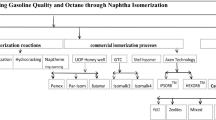Abstract
The isomerization process is a substantial technology to produce clean fuel from linear paraffinic species existing in light naphtha. We investigated the influence of hydrocracking reactions besides the other reactions on the research octane number (RON) of the isomerization product. A reaction network and a kinetic model including fifteen lumps and sixteen reactions were developed. Several experiments were carried out in a pilot plant to estimate kinetic parameters. The accuracy of the model was evaluated by comparing the model prediction with the experimental results. The maximum RON and process yield were strongly dependent on the temperature, hydrogen to hydrocarbon molar ratio (H2/Oil) and liquid hourly space velocity (LHSV). Also, increasing the reaction temperature compensated for the negative effects of raising the LHSV and H2/Oil in RON maximization. Moreover, we concluded that the hydro cracking reactions were very effective on RON, such that they can dominate the role of the other reactions. By sensitivity analysis in this research, a rule was obtained to declare the effect of operating condition on maximization of RON and the method of revamping of naphtha isomerization reactor.
Similar content being viewed by others
References
A.D. Estrada-Villagrana and C. Paz-Zavala, Fuel, 86, 1325 (2007).
S. Sadighi, S. Zahedi, R. Hayati and M. Bayat, Energy Technol., 1(12), 743 (2013).
P. Leprine, Conversion Processes, Editions Technip. (2001).
J. R. H. Ross, Heterogeneous Catalysis, Elsevier (2012).
R. G. Tailleur and J. B. Platin, J. Catal., 255(1), 79 (2008).
S. Sadighi, A. Ahmad and M. Shirvani, Chem. Eng. Technol., 35(5), 919 (2012).
K. Watanabe, N. Chiyoda and T. Kawakani, 18th Saudi Arabia-Japan Joint Symposium Dharan, Saudi Arabia, November 16-17 (2008).
R. Issadi, F. Garin and C. E. Chitour, Catal. Today, 113, 174 (2006).
R. G. Tailleur and C. Albornoz, Catal. Today, 150, 308 (2010).
K. Wantabe, T. Kawakami, K. Baba, N. Oshio and T. Kimira, Appl. Catal. A: Gen., 276, 145 (2004).
S. Zahedi Abghari, J. Towfighi Darian, R. Karimzadeh and M.R. Omidkhah, Korean J. Chem. Eng., 25(4), 681 (2008).
S. Sadighi, A. Ahmad and M. Rashidzadeh, Korean J. Chem. Eng., 27(4), 1099 (2010).
S. Zahedi Abghari, S. Shokri, B. Baloochi, M. Ahmadi Marvast, S. Ghanizadeh and B. Afshin, Korean J. Chem. Eng., 28(1), 93 (2011).
J. Sadeghzadeh Ahari, S. J. Ahmadpanah, A. Khaleghinasab and M. Kakavand, Petroleum Coal, 47(3), 26 (2005).
E.A. Medina and J.I.P. Paredes, Math. Comp. Model., 49, 207 (2009).
K. Surla, H. Vleeming, D. Guillaume and P. Galtier, Chem. Eng. Sci., 59, 4773 (2004).
A. Bernas and D. Y. Murzin, Chem. Eng. J., 115, 23 (2005).
F. Sandelin, T. Salmi and D. Yu. Murzin, Ind. Eng. Chem. Res., 45, 558 (2006).
H. S. A. Douwes, J. Mol. Catal. A: Chem., 272, 220 (2007).
M. Khurshid and S. Al-Khattaf, Appl. Catal. A: Gen., 368, 56 (2009).
N. V. Chekantsev, M. S. Gyngazova and E. D. Ivanchina, Chem. Eng. J., 238, 120 (2014).
J. Ancheyta, Modeling and simulation of catalytic reactors for petroleum refining, Wiley (2011).
D. S. G. Jones and P.R. Pujado, Handbook of petroleum processing, Springer (2006).
S. Parkash, Refining processes handbook, Elsevier (2003).
M.A. Fahim, T. A. Alsahhaf and A. Elkilani, Fundamental sof petroleum refining, Elsevier (2010).
M.R. Riazi, Characterization and properties of petroleum fractions, ASTM International Publishing (2005).
Author information
Authors and Affiliations
Corresponding author
Rights and permissions
About this article
Cite this article
Hayati, R., Abghari, S.Z., Sadighi, S. et al. Development of a rule to maximize the research octane number (RON) of the isomerization product from light naphtha. Korean J. Chem. Eng. 32, 629–635 (2015). https://doi.org/10.1007/s11814-014-0243-8
Received:
Accepted:
Published:
Issue Date:
DOI: https://doi.org/10.1007/s11814-014-0243-8




